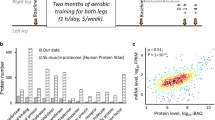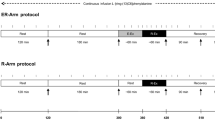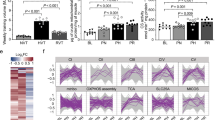Abstract
OBJECTIVE: The new uncoupling proteins, UCP2 and UCP3, are thought to play a role in energy efficiency in humans. Endurance training has been suggested to have effects on resting metabolic rate and energy efficiency. We therefore determined UCP2 and UCP3 mRNA levels in skeletal muscle of trained and untrained male subjects.
METHODS: Using reverse transcription-polymerase chain reaction (RT-PCR), expression of UCP2, UCP3L and UCP3S mRNA were measured in muscle biopsies from the quadriceps femoris in eight trained (23.9±1.6 y; 70.6±3.1 kg; 14±3% body fat; maximal power output (Wmax): 5.6±0.4 W/kg; mean±s.d.) and 10 lean, untrained (22.1±2.9 y; 72.0±7.9 kg; 18±4% body fat; Wmax: 3.9±0.4 W/kg; mean±s.d.) subjects. In six of the trained subjects, UCP2 and UCP3 mRNA were measured before and after an exercise bout to exhaustion. To correct for differences in mitochondrial content, levels of UCP2 and UCP3 mRNA were expressed relative to cytochrome-b, a marker of mitochondrial content.
RESULTS: Acute exercise had no effect on the expression of UCP3L or UCP3S, but in five out of six subjects UCP2 expression decreased after exercise, although the difference was not statistically significant (P=0.11). Trained subjects had significantly reduced mRNA levels of UCP3L (P=0.028) and UCP3S (P=0.031). VO2max expressed per kg of fat-free mass was negatively correlated with UCP3L (r=−0.61, P=0.009) and UCP3S (r=−0.52, P=0.028). Mechanical efficiency correlated negatively with UCP3L (r=−0.56, P=0.019), UCP3S (r=−0.47, P=0.048) and tended to correlate with UCP2 (r=−0.46, P=0.06).
CONCLUSION: The lower levels of UCP3 mRNA in trained subjects and the inverse relationship of UCP3 expression and mechanical efficiency suggest that exercise training produces an adaptive physiological response in skeletal muscle improving mechanical efficiency.
This is a preview of subscription content, access via your institution
Access options
Subscribe to this journal
Receive 12 print issues and online access
$259.00 per year
only $21.58 per issue
Buy this article
- Purchase on Springer Link
- Instant access to full article PDF
Prices may be subject to local taxes which are calculated during checkout
Similar content being viewed by others
Author information
Authors and Affiliations
Corresponding author
Rights and permissions
About this article
Cite this article
Schrauwen, P., Troost, F., Xia, J. et al. Skeletal muscle UCP2 and UCP3 expression in trained and untrained male subjects. Int J Obes 23, 966–972 (1999). https://doi.org/10.1038/sj.ijo.0801026
Received:
Revised:
Accepted:
Published:
Issue Date:
DOI: https://doi.org/10.1038/sj.ijo.0801026
Keywords
This article is cited by
-
Long-term effects of sprint interval training on expression of cardiac genes involved in energy efficiency
Sport Sciences for Health (2019)
-
Training-Induced Changes in Mitochondrial Content and Respiratory Function in Human Skeletal Muscle
Sports Medicine (2018)
-
Endurance training increases the efficiency of rat skeletal muscle mitochondria
Pflügers Archiv - European Journal of Physiology (2016)
-
Impact of UCP2 polymorphism on long-term exercise-mediated changes in adipocytokines and markers of metabolic syndrome
Aging Clinical and Experimental Research (2014)
-
Lack of UCP3 does not affect skeletal muscle mitochondrial function under lipid-challenged conditions, but leads to sudden cardiac death
Basic Research in Cardiology (2014)



